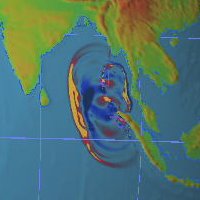Nothing in its history prepared Sri Lanka for the events of 26 December 2004 as the sea rushed onto the land around the entire circumference of the island. In some places the waves rose up to 12 meters and ran over 1 km inland. Nearly 31,000 people were killed instantly or later as a result of injuries. Over 500,000 people were left homeless as their homes were knocked down or washed away. Schools and libraries, religious buildings, shops and factories, railways and roads were destroyed around the entire periphery of Sri Lanka.
Bellanwila Rajamaha Vihara, through its Bellanwila Community Development Foundation (BCDF), began surveying the situation from the day of the disaster. During his first trip, on 29 December, to the devastated area south of Ambalangoda, Ven. Wimalaratna stopped to offer help in the village of Godagama Kahawa.

Ven. Paravahara Piyananda (left) and Ven. Bellanwila Wimalaratana
There wasn’t much of the village left standing but he met a group of young monks, led by Rev. Paravahara Piyananda, who were working tirelessly among the villagers giving what aid and comfort they could. Impressed with his energy and dedication, Ven. Wimalaratana promised to do whatever he could to help the people of Godagama Kahawa restore their lives. It was then that Ven. Wimalaratana and the Dayaka Sabha (temple committee) traveling with him decided to try to reconstruct the village by building new homes and repairing those that were damaged. For the next six weeks, Bhante and the Dayaka Sabha worked tirelessly to raise enough money, find surveyors, architects, contractors, draw up village plans and blueprints, designate a liaison with the villagers, and lobby the appropriate government representatives.

Government approval
On 11 February, all parties met at the Sri Wewekarama temple in Godagama and received final agreement and approval from all concerned.
Godagama is a small village that had 204 homes and 810 people before 26 December 2004. It is part of the larger village of Kahawa near the small resort town of Hikkaduwa. The official designation is Godagama, Kahawa, Hikkaduwa, Galle. (Postal Code: GL S 80312). It was particularly hard hit by the tsunami. Official survey documents indicate that the larger wave struck at 10:02 AM and reached a height of 10.04 meters (33 feet) based on chip marks on palm trees. The swirling waves inundated the village as far as 300 meters inland wiping out everything before it. The village lies along the railroad tracks just 3 kilometers north of Peraliya, where over 1000 lives were lost when the tsunami derailed a train .

The floorplan for new and rebuilt homes
The program began on 4 February, 2005 with a Shramadana village clean-up project organized by BCDF with two bus loads of volunteers from the Colombo temple. Contractors began work on Monday, 14 February. The original plan called to rebuild 40 homes that were fully destroyed. They would have 2 bedrooms and be approximately 500 sqft. Approximately USD 3500 was budgeted for each new home.
The plan also included repairs to 15 homes that were partially damaged. The total project cost over USD 150,000 for the construction and repairs alone.

Plat layout of new homesites adjacent to the temple purchased from old cinnamon plantation.
Through overwhelming generosity from around the world the original plan was completed as envisioned. In addition, enough land was purchased from an old cinnamon plantation adjacent to the temple to allow the construction of an additional 21 homes for those families who originally lived within the government mandated exclusion zone.


Pingback: Godagama-Kahawa, Sri Lanka « Kuruppukanda - the spirit of a village